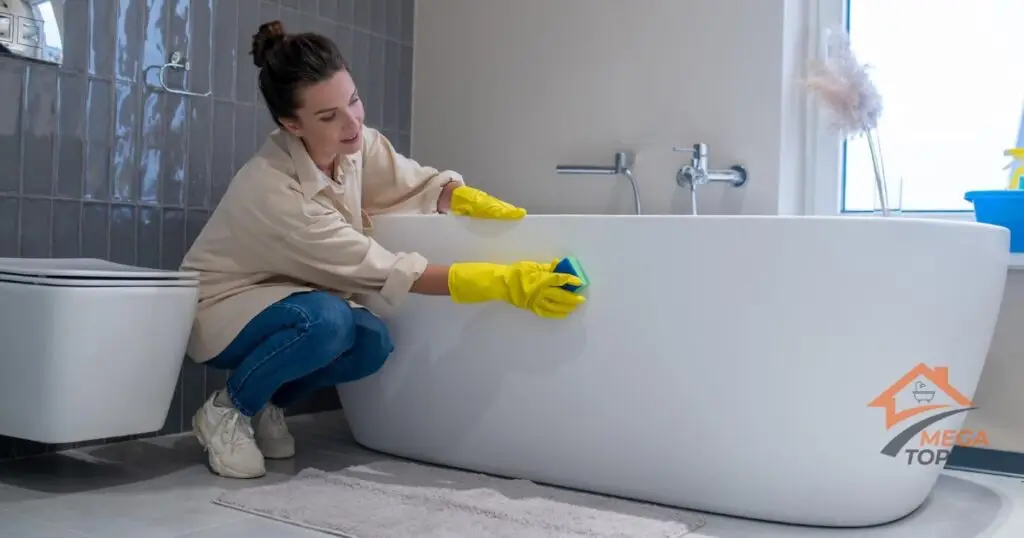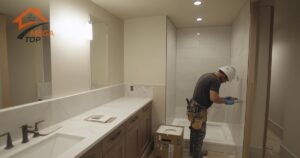What Is Bathtub Refinishing?
Bathtub refinishing, also known as resurfacing, is a process that restores the surface of a worn or damaged bathtub. It involves applying a new, durable finish to the tub, making it look and feel like new.
Understanding the Refinishing Process
Refinishing typically follows these steps:
- Preparation: Cleaning the bathtub surface thoroughly to remove soap scum, dirt, and grime.
- Repair: Filling chips, cracks, or other surface imperfections with filler materials.
- Etching and Priming: Applying a bonding agent to ensure the new finish adheres securely to the tub.
- Topcoat Application: Spraying a high-quality coating, often epoxy or polyurethane, to create a smooth, glossy surface.
Advantages of Refinishing
Refinishing offers several benefits:
- Cost-effective: It’s significantly cheaper than replacing a bathtub.
- Customizable: Choose from various colors and finishes to match your bathroom decor.
- Quick Process: Most refinishing jobs take only a few hours to complete.
Common Situations for Refinishing
- Surface Wear and Tear: Ideal for tubs with stains, scratches, or dull finishes.
- Budget Constraints: Refinishing is a practical alternative to replacement for homeowners on a budget.
- Historic Tubs: Great for preserving vintage or clawfoot bathtubs.
What Is Bathtub Reglazing?
Reglazing is a specific aspect of refinishing that focuses on restoring the tub’s topcoat. It provides a smooth, glossy finish that enhances the bathtub’s appearance.
The Reglazing Process Explained
Here’s how reglazing works:
- Surface Cleaning: Like refinishing, the surface must be spotless.
- Sanding: Lightly sanding the surface to ensure the coating adheres properly.
- Application of Topcoat: Using a specialized spray gun, professionals apply a glaze for a smooth and shiny surface.
Benefits of Reglazing
- Enhanced Appearance: Provides a sleek, brand-new look.
- Time-efficient: Reglazing is quicker than full refinishing and can often be done in one day.
- Affordable: Typically less expensive than refinishing.
When Reglazing Is the Best Option
- Minimal Damage: Reglazing works well for tubs with minor wear or discoloration.
- Short-term Solution: Ideal for quick updates before selling or renting a home.
Key Differences Between Refinishing and Reglazing
Understanding the differences between these two methods can help you decide which option is right for your tub.
Process Comparisons
- Refinishing: Involves repairing surface damage and applying a durable finish.
- Reglazing: Focuses on reapplying the tub’s surface glaze for aesthetic improvements.
Aesthetic and Durability Comparisons
- Refinishing: Offers more robust repairs and longer-lasting results.
- Reglazing: Primarily improves the tub’s appearance but may not address deep damage.
Cost and Time Considerations
- Refinishing usually costs more but lasts longer.
- Reglazing is quicker and cheaper but may require reapplication sooner.
DIY Tub Restoration vs Professional Services
Many homeowners are tempted to try DIY restoration methods, but professional services offer significant advantages.
Risks of DIY Refinishing and Reglazing
- Poor Results: DIY kits often lack the durability and finish of professional-grade materials.
- Health Hazards: Many refinishing chemicals emit harmful fumes, requiring specialized equipment for safe application.
- Limited Longevity: DIY results often don’t last as long as professional work.
Benefits of Hiring Professionals
- Expertise: Professionals ensure flawless application with specialized tools and materials.
- Durability: A professionally restored tub can last up to 15 years with proper care.
- Warranty Options: Many services include warranties for added peace of mind.
By choosing the right method—refinishing or reglazing—you can transform your bathtub’s appearance and functionality without the cost of replacement. Consult a professional today to determine the best option for your tub!
FAQ
Professional refinishing usually ranges between $300-$600, depending on the tub's condition and location.
While DIY kits exist, professional services ensure better results and longer-lasting finishes.
Both methods can last 10-15 years with proper care, but durability depends on the materials used.
They can address surface cracks, chips, and discoloration but won’t fix structural issues.
Reglazing can be a sustainable option as it avoids the waste of replacing an entire tub.





